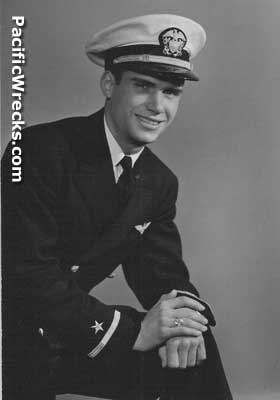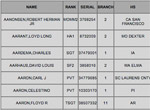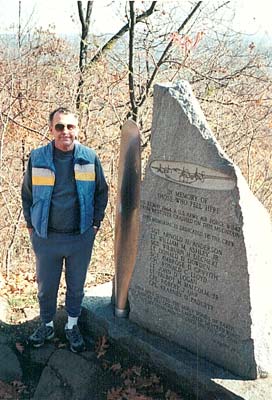Tell about your background and how got interested in WWII?
 Born and raised in Fall River, Massachusetts. My father was an AOM3c door gunner on PBM's and served with VPB-22 throughout WW II. Grew up listening to a lot of stories about the war. Joined the Marine Corps in 1969 and retired in 1999. Spent two tours in WesPac, including Vietnam, Okinawa, Japan and thirteen years in Hawaii. All that time in the Pacific led to the interest. Additionally on one of my tours at MCAS Cherry Point is was assigned to restore an F6F Hellcat 94263 and F4U 122189 for museums. To get parts for the planes I had to find old wrecks in the area. That started the interest in aircraft.
Born and raised in Fall River, Massachusetts. My father was an AOM3c door gunner on PBM's and served with VPB-22 throughout WW II. Grew up listening to a lot of stories about the war. Joined the Marine Corps in 1969 and retired in 1999. Spent two tours in WesPac, including Vietnam, Okinawa, Japan and thirteen years in Hawaii. All that time in the Pacific led to the interest. Additionally on one of my tours at MCAS Cherry Point is was assigned to restore an F6F Hellcat 94263 and F4U 122189 for museums. To get parts for the planes I had to find old wrecks in the area. That started the interest in aircraft.
Tell about your visit to the Hellcat piloted by Warnke
 Finding Ensign Harry N. Warnke started me in the direction of finding the MIA's and getting them back to their families. F6F Hellcat 41525 was Warnke's aircraft. The Navy was the first to visit the wreck shortly after the crash. They buried Warnke's remains at the site. (Warnke was not the only one buried at the crash site during the war but all of the others were recovered afterward. He was the only one left behind.). Found the site in 1991 and it took 15 years to get him recovered and identified.
Finding Ensign Harry N. Warnke started me in the direction of finding the MIA's and getting them back to their families. F6F Hellcat 41525 was Warnke's aircraft. The Navy was the first to visit the wreck shortly after the crash. They buried Warnke's remains at the site. (Warnke was not the only one buried at the crash site during the war but all of the others were recovered afterward. He was the only one left behind.). Found the site in 1991 and it took 15 years to get him recovered and identified.
Talk a little about your casualty database
 There is not an MIA database, per se. MIA (code-6) is one of seven disposition codes used in the Casualty Database. The Casualty Database contains the names of all US Armed Forces personnel lost during the war. As of this writing, the total number of records in the database is slightly over 377,000. (I can give you a better breakdown if you want it) I expect it to peak at 390,000 some time next year when I finish inputting the names of all those lost in the continental United States due to illness or accident. All overseas deaths are already in the database.
There is not an MIA database, per se. MIA (code-6) is one of seven disposition codes used in the Casualty Database. The Casualty Database contains the names of all US Armed Forces personnel lost during the war. As of this writing, the total number of records in the database is slightly over 377,000. (I can give you a better breakdown if you want it) I expect it to peak at 390,000 some time next year when I finish inputting the names of all those lost in the continental United States due to illness or accident. All overseas deaths are already in the database.
We have found it very important to list the names of the individuals and not just casualty figures. For example, the West Loch explosion. Most accounts list 163 lives as lost. Actual count was 110. State rosters have names and numbers but no one ever checked for duplication errors and there are thousands of them.
One of the more important points concerning the number of missing personnel is the actual count. The Department of Defense states that there are approximately 78,000 still missing from World War II and that number is wrong. The actual number of missing as of today is 72,768. Of this total, 26 are women. The reason for the confusion is they have combined the actual missing with those buried at sea (6,133). If you view the American Battle Monuments Commission (ABMC) webpage you’ll see the confusion as MIA’s will say Missing or Buried at Sea. There is no confusion in our database. [ View Casualty Database Excerpt ]
We've only covered the Casualty Database. There are several supporting databases which cover topics like aircraft losses, POW's, unknowns, etc. Total number of records in the databases is well over 600,000. I swear I'll be building or adding to databases as long as I live as more and more information becomes available all the time. The one database I would eventually like to eliminate is the one for the unknowns. If I can get them all identified, I won't need the database. Unfortunately there are over 10,000 more to do. Done a lot of work but allot more needs to be done.
My collaborator, Ray Emory is a Pearl Harbor Survivor. He was on the USS Honolulu the morning of the attack. He started working on the Pearl Harbor unknowns back in the mid-80's. Took a common sense approach to the problem by walking and recording all of the graves in the Punchbowl and building a database to keep track of them and all of the additional information he gathered. Ray should be considered the Godfather of the unknowns. He is the one that started us down this track and what an adventure it's been.
While he was doing his work, I was building aircraft databases. It was just a natural thing for us to come together as aircraft accidents produced casualties that are buried in the Punchbowl. We had known about each others work for years but finally met in late 1991 just before the 50th anniversary of the attack. Then I found the Warnke wreck and started taking the MIA issue much more seriously. We've been inseparable ever since.
It's a very unique relationship. We work together and independently at the same time. His focal point is the Pearl Harbor casualties. (Vested interest in the subject.) His database is for Navy, Marine and Coast Guard personnel. When I decided to build a casualty database I decided to do it for all services as the MIA issue is a world wide problem. If we could figure out the Punchbowl, why not all of the cemeteries?
I don't think our government wanted to take on the time and expense problems involved in creating such a database. Overall the Army wants the WW II Unknown / MIA issue to go away. Ray and I won't let that happen. We both believe that the family's are the only ones that should determine the final fate of their loved ones, not some apathetic bureaucrats.
What are your view on the recent MIA Database by DPMO?
It is a very funny coincidence that it was released following the MIA symposium at the Nimitz Museum. It is sad that it took them 60 years to get it done. [ Read DPMO News Release ] How many relatives have gone to their graves not knowing what happened to their loved ones. What I find most amusing is that Dr. Mansavage of the WW II working group was notified by me three years ago that the database was complete and commercially available. Probably would have been a fraction of the cost they ended up paying. Now they have wasted another three years, tied up thousands of man hours to compile a listing that is in the draft form at best. It will be years before they work all of the bugs out of it. That funding and time could have been much better utilized on actual case resolution. Ask yourself, if JPAC had had the funding how many more recoveries could they have accomplished. How many more MIA's would be coming home. In my opinion it is another case of waste, fraud and abuse by the government.
[ View First 25 US Navy Casualties vs. DPMO Service Personnel Not Recovered WWII ]
Is there a webpage version of the database?
 Visit WFI Research Group. Best to contact me direct by email concerning any projects or information required. Individual requests can vary greatly and have to be dealt with accordingly. But as with the books, any proceeds go directly into our MIA identifications / recoveries. I have handled aircraft research projects for BentProp.org and will no doubt handle others as we have a pretty good relationship. Worked with the 5th Armored Division earlier this year on the casualties in their division. Last year I did a home town report for Fall River and was able to show them a 23% increase in the number of vets lost during the war. The new memorial is thus much more accurate than the one erected in 1949.
Visit WFI Research Group. Best to contact me direct by email concerning any projects or information required. Individual requests can vary greatly and have to be dealt with accordingly. But as with the books, any proceeds go directly into our MIA identifications / recoveries. I have handled aircraft research projects for BentProp.org and will no doubt handle others as we have a pretty good relationship. Worked with the 5th Armored Division earlier this year on the casualties in their division. Last year I did a home town report for Fall River and was able to show them a 23% increase in the number of vets lost during the war. The new memorial is thus much more accurate than the one erected in 1949.
Your After the Battle article mentions only some WWII remains were embalmed
Few bodies were embalmed. For example, Navy Officers killed during the Pearl Harbor attack were embalmed at Bostwick Mortuary prior to interment at Halawa Naval Cemetery. After the war the skeletal remains of all were treated with and embalming compound, mostly to prevent odor rather than as a preservation agent. It does not interfere with DNA testing.
Anything else you wish to add about MIAs?
Everyone wants to point the finger at Joint POW / MIA Accounting Command (JPAC) for not getting the job done. This is totally unfair. On the MIA issue they are the governments first line of defense. Thus they get some of the credit and all of the blame. Ray Emory and I have worked with them for years and have managed to get 33 of these MIA cases cleared up or at least on there way to resolution. Without proper funding there is only so much they can do.
From a researcher point of view, JPAC's bosses at the Total Army Personnel Command (TAPC) in Arlington, Virginia are far more guilty of retarding the research and recovery efforts of the MIA's. They are the controlling authority for the Individual Deceased Personnel Files (IDPF"S). The records are actually held at the Washington Record Center in Suitland, Maryland.
Let me give you an example of why in my opinion they are holding America's MIA's for ransom and freely violate the guidelines of the Freedom of Information Act (FOIA) at will because no one can afford to fight them. If the reader has a missing family member from WW II I suggest you order the IDPF. It is the starting point for finding any MIA. If you are not sure someone is missing, just shoot me an email, I’ll look it up. [ Sample IDPF request form for MS Word ].
In the course of our research we’ve uncovered a wide variety of errors on the part of the Army. Some are understandable. So are unforgivable. Most, but not all, are correctable.
Let's say that Ray Emory and myself sat down tomorrow and decided we wanted to investigate the 400 unknowns in the Punchbowl that are associated with the loss of the Enoura Maru. This was a Japanese Hellship that was transporting American POW's to Japan but was caught by a carrier air group a Formosa Harbor and sunk. The Japanese recovered the bodies from the ship and buried them in a mass grave. After the war, the Army recovered the remains and buried them 20 to a casket in the Punchbowl as unknowns.
First we have to order the 400 IDPF's for the personnel on the ship and then we have to order the 400 IDPF's on the unknowns they buried. Grand total of 800 IDPF's. They charge us $28.00 for each one because they consider us "frequent requesters". They want a total of $22,400.00 for us to purchase the records, to do they job they have failed to do for sixty years. Under the provisions of the FOIA, there is no "frequent requester" status. Just can't fight city hall so to speak. (Just so the reader knows this is a real case. We have one of the cases resolved to prove our theory.)
As bad as I think the JAPC is, there are worse examples. But I need to explain a few things to keep it all in perspective.
The US Army was tasked with the recovery and return of all US war dead from overseas. If the death occurred within the confines of the Continental United States (CONUS), the individual branch of the service was responsible for the recovery and burial. But unlike the overseas burials where every unknown was re-examined and many identified, unknowns buried in CONUS were never re-examined. They were just left as unknowns. They can be found in just about every coastal state in CONUS. Let's take the case of Robert Johnson F3 US Navy that was resolved last year. [ Read News Article ]
He was one of 15 sailors lost when there lifeboat overturned while returning from liberty in Newport, Rhode Island. Twelve of the bodies were recovered and identified. One body was later recovered and buried as an unknown. Found him right where the Navy buried him in 1995. Took ten years to get him identified but we were finally able to do it. He now rests in Arlington, with a name.
What makes the case peculiar is that he is not listed as MIA. The other two bodies that were not recovered are but he wasn't. A little more research showed that there are many more cases just like his where the MIA is not reported as such. Have managed to find 37 of these graves so far but I'm sure there are many more out there. To get back on topic, this case brought me into contact with the Navy Casualty Office in Millington, Tennessee. All I can say at the moment is that the Army doesn't lie. Not so for the Navy. Let me explain.
When I was working on the 25 MIA sailors from The USS West Virginia at Pearl Harbor, three of the IDPF’s didn’t contain the dental files. I asked the Navy Casualty Office if they could provide them. After four months of waiting I received a call from them telling me that they had the files and they were being shipped overnight by Federal Express. That was in March 2006. I still haven’t seen the files. Thus I have 25 Navy unknowns hung up in limbo because of them. Hard for me to believe they care when they don’t cooperate.
What other projects are you presently working on?
Besides Pearl Harbor, the battles at Tarawa and Saipan are also in work. Tarawa is a little worse than most because not all of the Marine bodies were recovered from the island. If there is anyone out there that is missing a relative from Tarawa, please contact me as I need your help getting them all home.
Saipan is different as there are only 19 unknowns to contend with, but three of them are very sad cases. The body of Lt. Woodie L. McVay pilot of F6F Hellcat 04908 was lost by the U.S. Army after he was identified. Two other aviators were executed by the Japanese when Saipan was invaded. I want to bring them all home to their families by these three above all.
I have just started reviewing Grand Failly Cemetery in France. This was a temporary cemetery, but one of the two main feeder cemeteries into Hamm Cemetery, Luxembourg, which contains 101 unknowns. It is our first major effort in Europe and the results look promising at the moment.